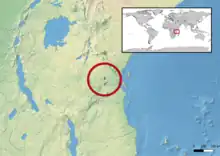| Fischer's chameleon | |
|---|---|
.jpg.webp) | |
| Drawing of purported Fischer's chameleons (male above and female in the middle; but see taxonomy) and Rieppeleon brevicaudatus (bottom) | |
| Scientific classification | |
| Domain: | Eukaryota |
| Kingdom: | Animalia |
| Phylum: | Chordata |
| Class: | Reptilia |
| Order: | Squamata |
| Suborder: | Iguania |
| Family: | Chamaeleonidae |
| Genus: | Kinyongia |
| Species: | K. fischeri |
| Binomial name | |
| Kinyongia fischeri (Reichenow, 1887) | |
 | |
| Synonyms[2] | |
Fischer's chameleon (Kinyongia fischeri), also known commonly as the Nguru blade-horned chameleon and the Nguru two-horned chameleon, is a species of chameleon, a lizard in the family Chamaeleonidae. The species is endemic to Tanzania.
Etymology
The specific name, fischeri, is in honor of German herpetologist Johann Gustav Fischer.[3]
Geographic range
K. fischeri is restricted to the Nguru and Nguu Mountains of Tanzania.[2][4] Chameleons found in other parts of the Eastern Arc Mountains in Tazania as well as Kenya are now classified as separate species.[4][5]
Habitat
The preferred natural habitat of K. fischeri is forest, at altitudes up to 1,500 m (4,900 ft).[1]
Taxonomy
A number of other species (K. boehmei, K. matschiei, K. multituberculata, K. tavetana, K. uluguruensis, and K. vosseleri) have formerly been included as subpopulations of K. fischeri or classified as its subspecies. In 1991, it was recommended that K. tavetana (including K. boehmei) should be recognized as a species distinct from K. fischeri,[6] and in 2008 it was shown that all the remaining also should be recognized as their own, distinct species.[4][5] This means that the true Fischer's chameleon has a far more restricted distribution than previously believed and it does not overlap with the distributions of any of the other species in this group.[4][5]
Reproduction
In captivity
Although formerly considered common in captivity, virtually all "Fischer's chameleons" historically exported out of Tanzania were instead its close relatives (especially K. multituberculata, but also K. matschiei and K. vosseleri, and possibly a couple of other species). As of 2013, only three true K. fischeri were confirmed to have ever been exported in the captive trade.[1]
References
- 1 2 3 Tolley, K.; Menegon, M. (2014). "Kinyongia fischeri ". IUCN Red List of Threatened Species. 2014: e.T172565A1345554. doi:10.2305/IUCN.UK.2014-3.RLTS.T172565A1345554.en. Retrieved 20 November 2021.
- 1 2 3 Kinyongia fischeri at the Reptarium.cz Reptile Database. Accessed 2 July 2017.
- ↑ Beolens, Bo; Watkins, Michael; Grayson, Michael (2011). The Eponym Dictionary of Reptiles. Baltimore: Johns Hopkins University Press. xiii + 296 pp. ISBN 978-1-4214-0135-5. (Kinyongia fischeri, p. 90).
- 1 2 3 4 Mariaux J, Lutzmann N, Stipala J (2008). "The two-horned chamaeleons of East Africa". Zoological Journal of the Linnean Society. 152 (2): 367–391. doi:10.1111/j.1096-3642.2007.00332.x.
- 1 2 3 Lutzmann N (2008)."Some important changes in the systematics of Bradypodion FITZINGER, 1843". Chameleons! Online E-Zine. chameleonnews.com
- ↑ Broadley, D.G.; Howell, K.M. (1991). "A check list of the reptiles of Tanzania, with synoptic keys". Syntarsus. 1: 1–70.
Further reading
- Nečas P (1999). Chamaeleons—Nature's Hidden Jewels. Frankfurt am Main: Edition Chimaira. 348 pp. ISBN 3-930612-04-6 (Europe), ISBN 1-57524-137-4 (USA, Canada). (Bradypodion fischeri, new combination, p. 191).
- Reichenow A (1887). "Neue Wirbelthiere des Zoologischen Museums in Berlin ". Zoologischer Anzeiger 10: 369–372. (Chamaeleon fischeri, new species, pp. 371–372). (in German).
- Tilbury CR, Tolley KA, Branch WR (2006). "A review of the systematics of the genus Bradypodion (Sauria: Chamaeleonidae) with the description of two new genera". Zootaxa 1363: 23–38. (Kinyongia fischeri, new combination).
